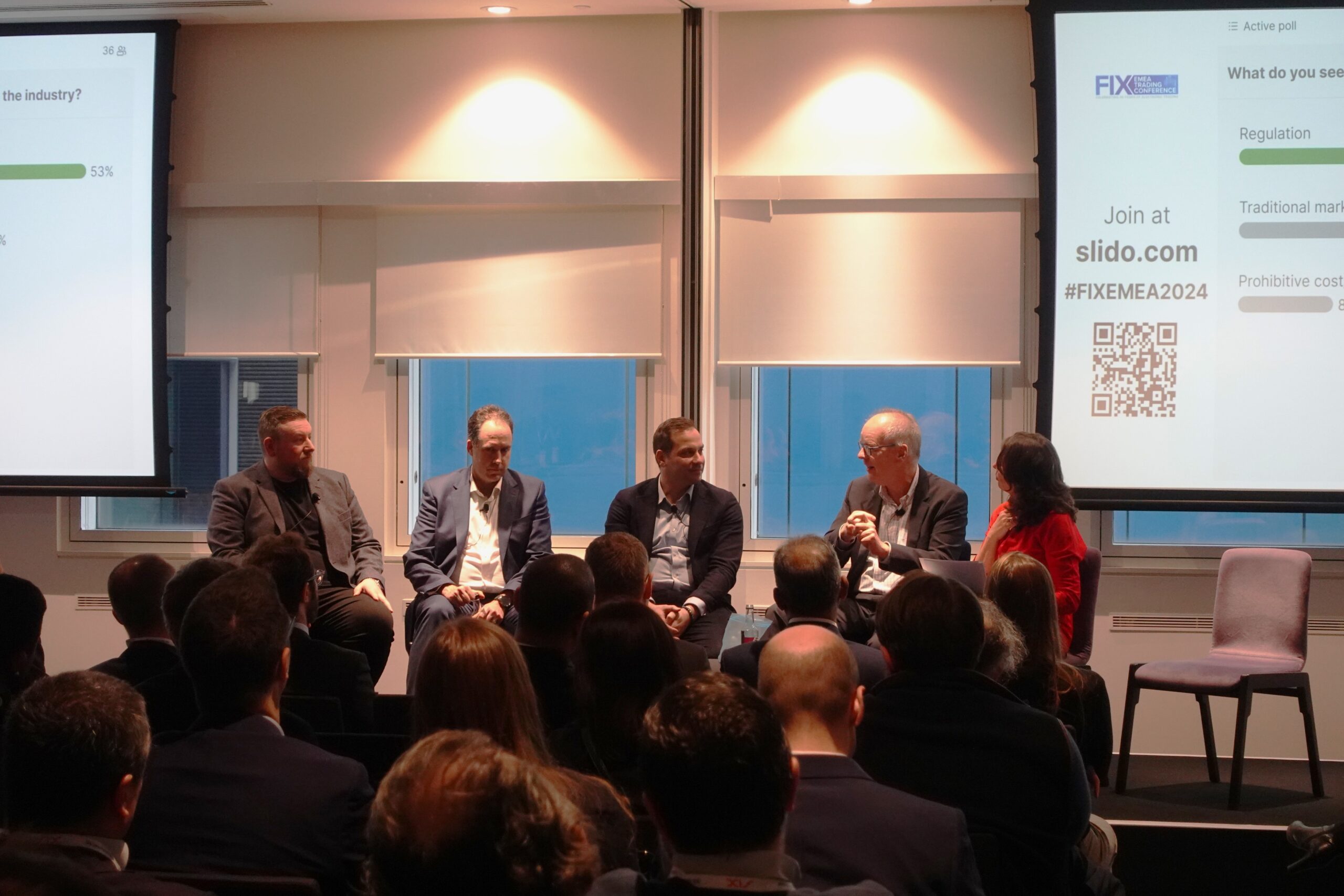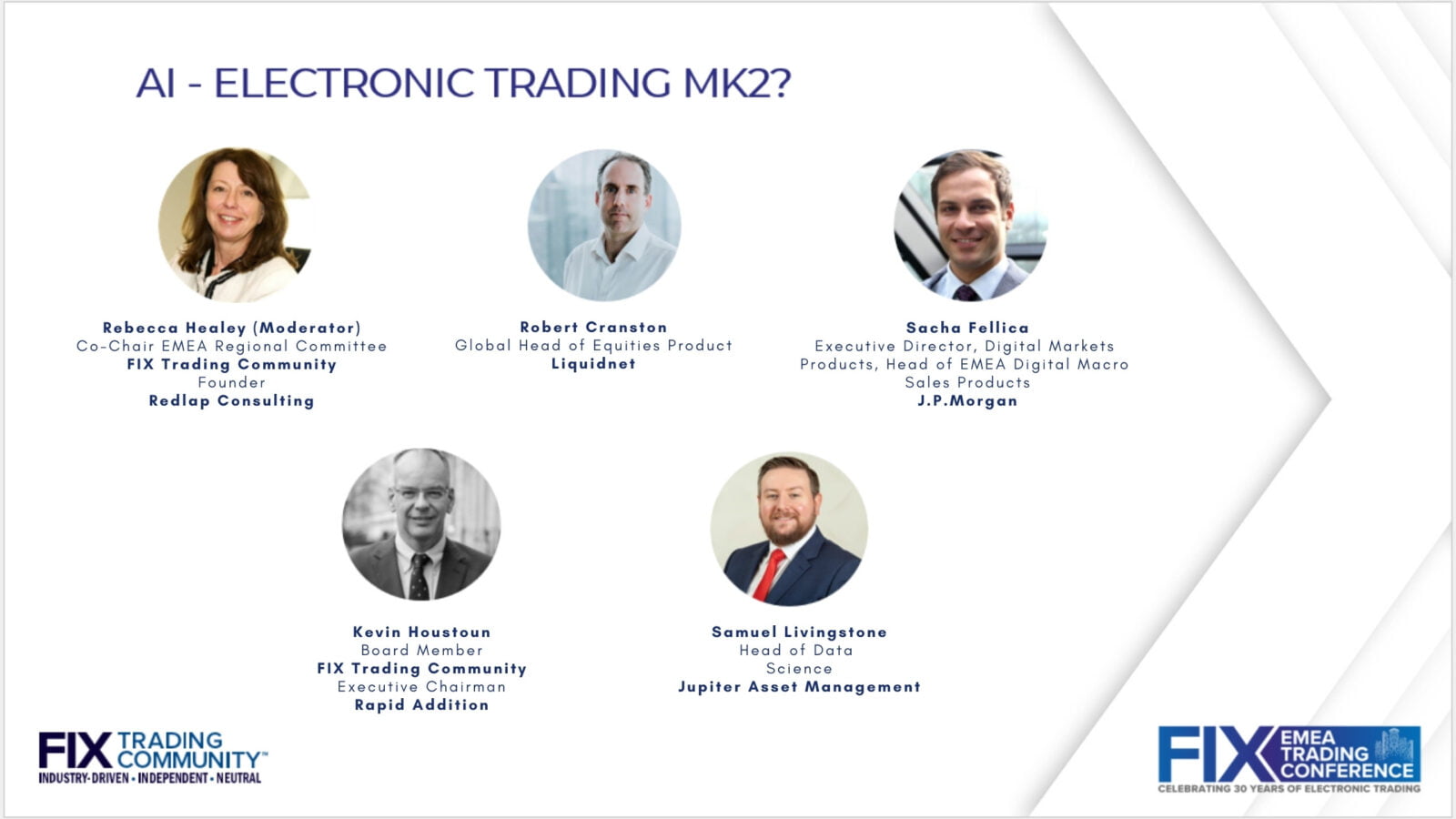The intersection of artificial intelligence (AI) and electronic trading has been a subject of fervent discussion, particularly in the financial industry where innovation can lead to significant potential gains. At the recent EMEA Trading Conference organized by The FIX Trading Community in London, a panel of industry leaders convened to dissect the role of AI in electronic trading.
Among the speakers was Kevin Houstoun, Chairman of Rapid Addition and Board Member of The FIX Trading Community, who provided invaluable insights during a panel discussion that delved deep into the implications, challenges, and future prospects of AI in trading. Joining Kevin on the panel were Rob Cranston – Global Head of Equities Product at Liquidnet, Sacha Fellica – Executive Director, Product Management, Digital Markets in a tier 1 bank, Samuel Livingstone – Founder of Eco AI, and Rebecca Healey, Founder of Redlap Consulting, who moderated the session.
Practical Implications of AI/ ML in Finance
The discussion commenced with a critical question: Do people truly grasp the distinction between machine learning and AI? Despite the prevalent hype surrounding AI, it was argued that machine learning, a subset of AI, has been utilized in trading for many years. However, the rapid evolution of Generative AI and Large Language Models (LLMs) has unlocked new possibilities, prompting the need for a hard look at the rapidly emerging potential for such technology.
The panellists elaborated on the practical applications of AI in trading, emphasizing its role as a productivity tool rather than a standalone decision-maker. From analysing large textual datasets to summarizing regulatory documents, AI offers unparalleled efficiency in processing vast amounts of information, enabling traders to make more informed decisions swiftly.
However, cautionary notes were sounded regarding the reliance on AI-generated insights. While AI can augment decision-making processes, human interpretation remains paramount. The notion of AI serving as a “co-pilot” rather than a sole navigator was emphasized, stressing the importance of analytical rigour and critical thinking in validating AI-driven outputs.
Challenges with AI Adoption in Trading
One of the pivotal points raised was the regulatory hurdles obstructing the evolution of AI in the financial sector. An audience poll revealed that regulation was perceived as the greatest obstacle, underlining the necessity for a cohesive approach to address regulatory concerns while fostering innovation. Adoption is therefore likely to be in areas that don’t cross the regulatory threshold in the near term.
Furthermore, the discussion highlighted the imperative of quality data, echoing the adage “garbage in, garbage out.” As with ML, the veracity of output from AI is dependent on the quality of data it is trained on. Sam Livingstone has identified talent, technology, and data as the three pillars essential for the successful implementation of AI in trading operations. Kevin expressed reservations regarding the readiness of LLMs for trading applications, advocating for caution and reliance on more established models, such as neural nets.
Despite the rapid pace of technological advancement, the panel underscored the need for transparency and oversight in AI systems. Explainability emerged as a crucial concern, with unanimous agreement that complete autonomy in trading decisions remains a distant prospect. Rob Cranston made clear this is a critical part of any adoption of AI into trading workflows due to strict client as well as regulatory requirements. Hence, efforts to address the interpretability of AI-generated insights are imperative to maintain trust and mitigate risks.
Next Steps for Successful Adoption of AI in Trading
In light of these considerations, the panel concluded that while AI holds immense potential in transforming electronic trading, pragmatic approaches are warranted. Additionally, calls were made for collaborative efforts, including the establishment of an FPL Working Group on AI, to navigate the complex regulatory landscape and ensure responsible AI adoption in our industry.
Ultimately, the journey towards integrating AI into electronic trading necessitates a balanced approach that harnesses innovation while safeguarding against unforeseen risks. By fostering a culture of collaboration, regulatory diligence, and technological sophistication, the financial industry can unlock the full potential of AI as a catalyst for growth and efficiency in electronic trading.


